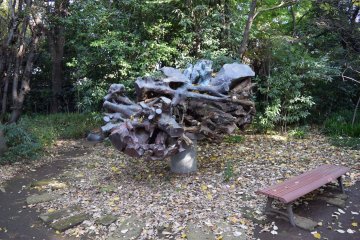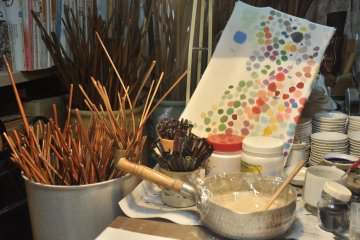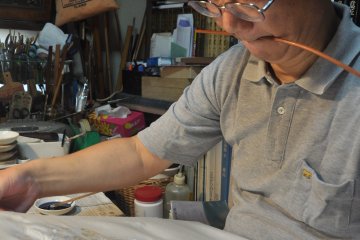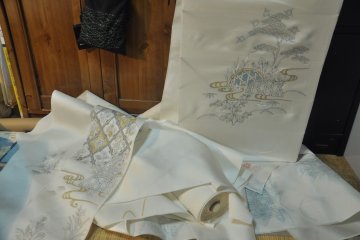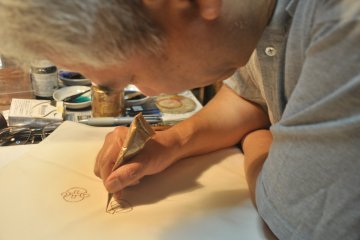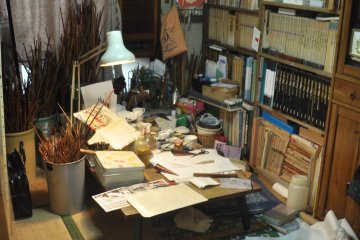Yuzen is a Japanese traditional art that has been handed down for several centuries. Yuzen relates to a specific painting and dying process, in which stencils and rice paste is used to produce graphic designs on silk or other fabric.
Iwama Susumu has been a practitioner of yuzen painting for more than thirty years. His workshop is located in a tiny room inside his home. A table takes up most of the small space, and is covered with paintbrushes, small porcelain dishes, bottles of colorful pigments and wooden sticks used for framing a piece of cloth for sketching. A trapdoor in the middle of the table opens to reveal a silver heater underneath that is used to dry the paint. Iwama sits on the floor in the tiny space between the table and the cupboard behind him while he is working. Almost all necessities for his work are reachable without the need to stand up or move.
The best kimono have their designs hand-drawn directly onto the cloth’s surface, which requires sophisticated skills of sketching, coloring and dyeing. To make the sketch, a thin outline of the picture is made. Sometimes, slightly thicker lines differentiate various color fields, and acts to prevent colors from running over to the next field during the later steps of the dying process. With a cone shape tool made from tree skin, Iwama’s right hand slides slowly and smoothly across the cloth, continuously squeezing this golden material on it. (It could be milky white or black too, depending on the design of the picture). After a few minutes, a beautiful picture appears on the white cloth, in this case a portrait of moving clouds drifting aimlessly through gardens and plants. But this is only part of the whole picture that he is completing. There is still much to be drawn. Next he also demonstrates how gold leaves or gold dust are applied. Sometimes they are trimmed from a whole piece of gold leaf; while other times it is applied with a sift moving over the designated areas.
Before long, I have the chance to experience the painting process for myself. A number of traditional Japanese ceremonial objects are outlined for me, this time by the use of just a piece of plastic instead of tree skin. The objects include toys, traditional musical instruments and old coins. My task is to paint them with colors. As the objects are rather small and intricate, it requires extremely high concentration and patience, since it would be hard to make amendments if you paint across the line. Under Iwama’s guidance, I apply specific colors for certain sections; the remainder I am free to paint according to my own desire. Every time before a new color can be applied, the liquidity and consistency of the paint has to be examined in case they are too thick or too pale.
While fifteen minutes of intense concentration on my part may seem like an eternity, Iwama shares that he can work for eight to ten hours a day. This intense focus and insistence on perfection has clearly allowed him to excel at his chosen artistic profession.
In addition to working in his own workshop, Iwama also gives lectures on yuzen methods at schools and museums to adults and children alike. In the near future, he plans on organizing an exhibition on Japanese traditional handicrafts in cooperation with other arts specialists and craftsmen.




